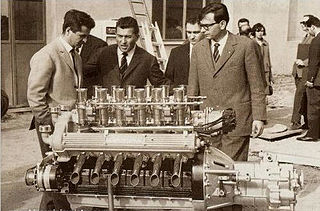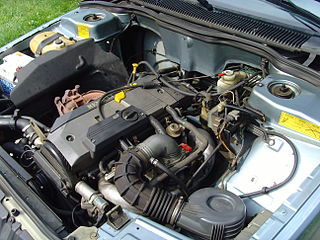Related Research Articles

The straight-six engine is an internal combustion engine, with six cylinders mounted in a straight line along the crankcase with all the pistons driving a common crankshaft.

The LA engines are a family of pushrod OHV small block 90° V-configured gasoline engines built by Chrysler Corporation. It was factory-installed in passenger vehicles, trucks and vans, commercial vehicles, marine and industrial applications from 1964 through 1991 (318) & 1992 (360). The combustion chambers are wedge-shaped, rather than the polyspherical combustion chambers in the predecessor A engine or the hemispherical combustion chambers in the Chrysler Hemi engine. LA engines have the same 4.46 in (113 mm) bore spacing as the A engines. LA engines were made at Chrysler's Mound Road Engine plant in Detroit, Michigan, as well as plants in Canada and Mexico. The "LA" stands for "Light A", as the 1956 - 1967 "A" engine it was closely based on and shares many parts with was nearly 50 pounds heavier. The "LA" and "A" production overlapped from 1964 - 1966 in the US and through 1967 in export vehicles when the "A" 318 engine was phased out. Willem Weertman, who later became Chief Engineer – Engine Design and Development, was in charge of the conversion. The basic design of the LA engine would go unchanged through the development of the "Magnum" upgrade (1992-1993) and into the 2000s with changes to enhance power and efficiency.

The Eagle Premier is a full-size executive car that was developed by American Motors Corporation (AMC) during the 1980s through its partnership with Renault. This model was manufactured in the then-brand-new Brampton Assembly in Canada. Chrysler Corporation bought the rights to the Premier when it acquired Renault's outstanding shares in AMC in 1987, and began selling the car under the new Eagle marque.

The initial design development for the PowerTech V6 and V8 engine family was done by American Motors Corporation (AMC) and debuted in 1998 with credit to Chrysler. This was the first new V8 engine for Chrysler since the 1960s. The companion V6 was basically the V8 with two fewer cylinders, another concept that originated at AMC before the company joined Chrysler. These new engines had nothing in common with the Chrysler A engine V8s, nor the Jeep 4.0 L "PowerTech" I6 engine.

The Iron Duke engine is a 151 cu in (2.5 L) Straight-4 piston engine built by the Pontiac Motor Division of General Motors from 1977 to 1993. Thereafter GM's 2.2 L OHV 4-cylinder replaced it across the entire lineup of vehicles that offered it. Although its original purpose was to serve as Pontiac's new economy car engine, it was later adapted for use in a wide variety of applications across GM's lineup in the 1980s.

The Renault 21 is a large family car produced by French automaker Renault between 1986 and 1994. It was also sold in North America initially through American Motors dealers as the Renault Medallion and later through Jeep-Eagle dealers as the Eagle Medallion. A total of 2,096,000 units were produced.

The Lamborghini V12 refers to the flagship V12 engine used by Lamborghini. Lamborghini has had two generations of V12 engines through their history, both of which were developed in-house. The first-generation Lamborghini V12 was a sixty degree (60°) V12 petrol engine designed by Lamborghini, and was the first internal combustion engine ever produced by the firm.

The AMC V8 may refer to either of two distinct OHV V8 engine designs that were developed and manufactured by American Motors Corporation (AMC). The engines were used in cars and trucks by AMC, Kaiser, and International Harvester as well as in marine and stationary applications.

The American Motors Corporation (AMC) straight-6 family of engines was used in AMC passenger cars and Jeep vehicles from 1964 through 2006.
The Computerized Engine Control or Computerized Emission Control (CEC) system is an engine management system designed and used by American Motors Corporation (AMC) and Jeep on 4- and 6-cylinder engines of its own manufacture from 1980 to 1990. It is one of the three major components for proper engine operation: the computer, electrically controlled carburetor, and the oxygen sensor in the enhaust system.
Jetronic is a trade name of a manifold injection technology for automotive petrol engines, developed and marketed by Robert Bosch GmbH from the 1960s onwards. Bosch licensed the concept to many automobile manufacturers. There are several variations of the technology offering technological development and refinement.

The Honda D series inline-four cylinder engine is used in a variety of compact models, most commonly the Honda Civic, CRX, Logo, Stream, and first-generation Integra. Engine displacement ranges between 1.2 and 1.7 liters. The D Series engine is either SOHC or DOHC, and might include VTEC variable valve timing. Power ranges from 66 PS (49 kW) in the Logo to 130 PS (96 kW) in the Civic Si. D-series production commenced 1984 and ended 2005. D-series engine technology culminated with production of the D15B 3-stage VTEC (D15Z7) which was available in markets outside of the United States. Earlier versions of this engine also used a single port fuel injection system Honda called PGM-CARB, signifying the carburetor was computer controlled.

The Chrysler Hemi engines, known by the trademark Hemi, are a series of American I6 and V8 gasoline engines built by Chrysler with overhead valve hemispherical combustion chambers. Three different types of Hemi engines have been built by Chrysler for automobiles: the first from 1951 to 1958, the second from 1964 to 1971, and the third beginning in 2003. Although Chrysler is most identified with the use of "Hemi" as a marketing term, many other auto manufacturers have incorporated similar designs. The engine block and cylinder heads were cast and manufactured at Indianapolis Foundry.

Motronic is the trade name given to a range of digital engine control units developed by Robert Bosch GmbH which combined control of fuel injection and ignition in a single unit. By controlling both major systems in a single unit, many aspects of the engine's characteristics can be improved.

The Douvrin family was an all-aluminum inline-four automobile engine designed in the early 1970s and produced from 1977 to 1996 by Compagnie Française de Mécanique, a joint-venture between PSA and Renault located in the town of Douvrin in northern France. This engine is designed by the engineer Jean-Jacques His. It was produced in the same factory as the PRV V6, which also is sometimes known outside France as the "Douvrin" V6. The Douvrin engine is also referred to as the ZDJ/ZEJ engine by Peugeot, and as the J-type engine by Renault.

F Renault engine is an automotive internal combustion engine, four-stroke, inline-four engine bored directly into the iron block, water cooled, with overhead camshaft driven by a timing belt, and with an aluminum cylinder head, developed and produced by Renault in the early '80s, making its appearance on the Renault 9 and 11. This engine is available in petrol and diesel versions, with 8 or 16 valves.

The AMC straight-4 engine is a 2.5 L inline-four engine developed by American Motors Corporation (AMC) that was used in a variety of AMC, Jeep, and Dodge vehicles from 1984 to 2002.

SECU-3 is an internal combustion engine control unit. It is being developed as an open source project. Anyone can take part in the project, and can access all the information without any registrations.
The Bendix Electrojector is an electronically controlled manifold injection (EFI) system developed and made by Bendix Corporation. In 1957, American Motors (AMC) offered the Electrojector as an option in some of their cars; Chrysler followed in 1958. However, it proved to be an unreliable system that was soon replaced by conventional carburetors. The Electrojector patents were then sold to German car component supplier Bosch, who developed the Electrojctor into a functioning system, the Bosch D-Jetronic, introduced in 1967.
References
- Boccadoro, V.; Kizer, T. (1984). Adaptive spark control with knock detection. Warrendale, PA: Society of Automotive Engineers. OSTI 5702572.
- Freeman, Kerry A. (1987). Chilton's guide to emission diagnosis, tune-up and vacuum diagrams, 1984-87 domestic cars. Chilton. pp. 390–490. ISBN 9780801977565 . Retrieved 17 April 2013.
- Mitchell's Electronic Fuel Injection Troubleshooting Guide: Domestic Vehicles (chapter contents include AMC/Jeep; AMC; AMC/RENIX; AMC/RENIX II). Mitchell International. 1991. ISBN 978-1-55561-032-6.